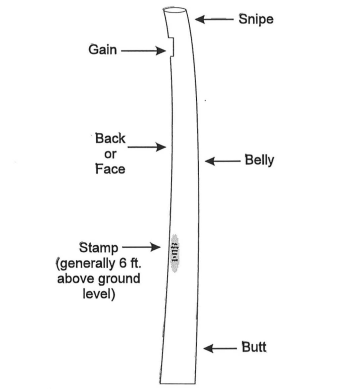9 Topic: Wood Pole Characteristics (20m)
Instructions
- Cover the following content as a group (either reading out loud or independently) then give an opportunity to answer any questions.
- Have students do the review questions independently, then take up answers.
Parts of Wooden Pole
There are six main parts to a wooden pole:
- Snipe
- Butt
- Belly
- Back (face)
- Gain
- Stamp
Below is a diagram illustrating the six main parts of a wooden pole

1. Snipe
The snipe is the top of the pole. It is the circumference (inches or millimetres) at the top.
2. Butt
The butt is the end of the pole which is set in the hole (large end.) It is also the circumference (inches or millimetres) at the bottom. The hole in which the pole is being set must be eight inches larger in diameter.
3. Belly
The belly is the side of the pole that curves outward like a person’s belly.
All trees in nature grow in a slightly curved fashion. This curve remains throughout its life and gives all power poles a slight curve, referred to as the belly.
4. Back (Face)
Using a person’s body as a comparison, if a pole has a belly, then it’s opposite side must be the back.
The back of a pole is sometimes referred to as the “face”. This is because the back (or inside curve) is the strongest side of the pole, due to the natural wood grain structure of the tree itself. Therefore, the equipment or line which will cause the most strain is fastened to the back (you must “face” the strain.)
5. Gain
The “gain” is the notch cut in the snipe of a pole to allow a crossarm to sit flat. Most crossarm construction is built on 35 to 45 foot poles, and have been gained at the factory. Poles which are longer, are not.
Since crossarms should be on the strong side of the pole (back), gains are cut to this side. This is why the back side of a pole is also called the “gain.”
6. Stamp
The stamp is usually (but not always) on the back side of the pole and six feet above ground level. The stamp contains six pieces of information:
- Length
- Poles come in a variety of lengths
- Five foot increments
- Treat
- Poles are treated with various chemicals to prevent rot
- “C” is Creosote, “P” is Pentachlorophenol
- Type
- Type of tree the pole was cut from
- J.P. – Jack Pine
- L.P.P. – Lodge Pole Pine
- W.R.C. – Western Red Cedar
- Type of tree the pole was cut from
- Manufacturers
- The company that cut and treated the pole
- Examples are Bell, Stella Jones (SJI) etc.
- Year
- Year of cutting
- Class
- This is the strength rating of a pole
- Rated by the circumference at the snipe and six feet up from the butt (roughly ground level where strain becomes a factor)
- Rated generally from one (very strong) to seven (light pole)
- The lower the grade, the more breaking strength a pole has
- Note: The class of a pole can be changed in two ways:
- If you cut five feet from the top of a pole, it will drop a class. A class 4, 45 foot pole with 5 feet cut off the top becomes a class 3, 40 foot pole.
- A used pole (provided it is undamaged) is reclassified to add 1 Class. A class 3, 55 foot pole, after being used, is now a Class 4, 55 foot pole.
Review Questions: Wood Pole Characteristics (30m)
|
|||||
|
|
|
||||
|
|
|
||||
|
|
|
||||
|
T / F |
|
||||
|
|||||
|
|
|
||||
|
|
|
||||
|
|
|
||||
|
T / F |
|
||||
Answer Key
1. snipe, butt, belly, back (face), gain, stamp, 2. A, 3. Belly, 4. D, 5. F, 6. Length, treat, type, manufacturer, year, class, 7. A, 8. 6, 3, 9. 4/45, 2/40, 10. snipe
